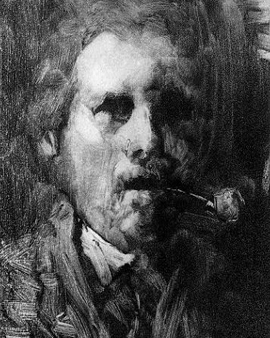Otto Henry Bacher was born in Ohio. He spent his childhood in Cleveland, living on a river that flows into Lake Erie. Lured by the ships and bustle of the harbor, Otto spent many hours here. To pass the time, Bacher began sketching the scenes of harbor life. Bacher earned his first money as a painter by painting inscriptions on merchant ships. His interest in art awakened in his teens, and so the young American decided to study art. The painter De Scott Evans was one of the first teachers of the dedicated artist. Bacher spent a short time at the art school in Pennsylvania, but broke off his studies and devoted himself to learning the etching technique. From this point on, he also began a lively exchange with the European art world. Bacher regularly visited Europe. Artistic development was very progressive in Europe and especially in the art centers of the time in Munich, Paris and Florence. American art was subject to this influence with a delay. Otto Bacher used his stays in Europe to refine his education. His life was one of constant learning and he was one of the driving forces for the advancement of American art.
Otto Bacher made a name for himself for his etchings and illustrations. The artist also produced paintings in oil, but the success of these works remained moderate. Bacher developed into a sought-after illustrator. He produced pictures for books and magazines and was a founding member of the Society of Illustrators. Incredibly impressive is the circle of his closer contacts within the art scene. Bacher was in close exchange with fellow artists in America and Europe. There were rarely phases in his creative life when he was not in collaboration. The European art scene inspired Bacher and he adopted the approaches of the French Impressionists and is considered one of the first Impressionists in the American art world.
Bacher had an unusually intense creative period for the 19th century. At exhibitions, the artist often showed his first etchings, from his time in Cleveland. European audiences were fascinated by the insights Bacher offered them. The artist spent a remarkably long time in Venice. The city seemed to captivate him. Together with the artist friend Frank Duveneck Otto Bacher set up a studio in the city. He had his etching equipment brought there and together the artists captured impressions of the city. During their collaboration, the artists produced some early works that are counted as modern monotypes. This printing technique allows only a single impression of the original. The artist spent the last two decades of his life in New York. In addition to making illustrations, he worked on paintings for exhibitions in America and Europe.
×





.jpg)
.jpg)
.jpg)
.jpg)
.jpg)
.jpg)
.jpg)
.jpg)
.jpg)
.jpg)
.jpg)
.jpg)
.jpg)
.jpg)
.jpg)
.jpg)
.jpg)
.jpg)
.jpg)
.jpg)
.jpg)
.jpg)
.jpg)
.jpg)
.jpg)
.jpg)
.jpg)
.jpg)
.jpg)
.jpg)
.jpg)
.jpg)
.jpg)
.jpg)
.jpg)
.jpg)
.jpg)
.jpg)
.jpg)
.jpg)
.jpg)
.jpg)
.jpg)
.jpg)
.jpg)
.jpg)
.jpg)
.jpg)
.jpg)
.jpg)
.jpg)
.jpg)
.jpg)
.jpg)
.jpg)
.jpg)
.jpg)
.jpg)
.jpg)
.jpg)
.jpg)
.jpg)
.jpg)
.jpg)
.jpg)
.jpg)
.jpg)
.jpg)
.jpg)
.jpg)
.jpg)
.jpg)
.jpg)
.jpg)
.jpg)
.jpg)
.jpg)
.jpg)
.jpg)
.jpg)
.jpg)
.jpg)
.jpg)
.jpg)
.jpg)
.jpg)
.jpg)
.jpg)
.jpg)
.jpg)
.jpg)
.jpg)
.jpg)
.jpg)
.jpg)
.jpg)
.jpg)
.jpg)
.jpg)
.jpg)
.jpg)
.jpg)
.jpg)
.jpg)
.jpg)
.jpg)
.jpg)
.jpg)
.jpg)
.jpg)
.jpg)
.jpg)
.jpg)
.jpg)
.jpg)
.jpg)
.jpg)
.jpg)
.jpg)
.jpg)
.jpg)
.jpg)
.jpg)
.jpg)
.jpg)
.jpg)
.jpg)
.jpg)
.jpg)
.jpg)
.jpg)
.jpg)
.jpg)
.jpg)
.jpg)
.jpg)
.jpg)
.jpg)
.jpg)
.jpg)
.jpg)
.jpg)
.jpg)
.jpg)
.jpg)
.jpg)
.jpg)
.jpg)
.jpg)
.jpg)
.jpg)
.jpg)
.jpg)
.jpg)
.jpg)
.jpg)
.jpg)
.jpg)
.jpg)
.jpg)
.jpg)
.jpg)
.jpg)
.jpg)
.jpg)
.jpg)
.jpg)
.jpg)
.jpg)
.jpg)
.jpg)
.jpg)
.jpg)
.jpg)
.jpg)
.jpg)
.jpg)
.jpg)
.jpg)
.jpg)
.jpg)
.jpg)
.jpg)
.jpg)
.jpg)
.jpg)
.jpg)
.jpg)
.jpg)
.jpg)
.jpg)
.jpg)
.jpg)
.jpg)
.jpg)
.jpg)
.jpg)
.jpg)
.jpg)
.jpg)






